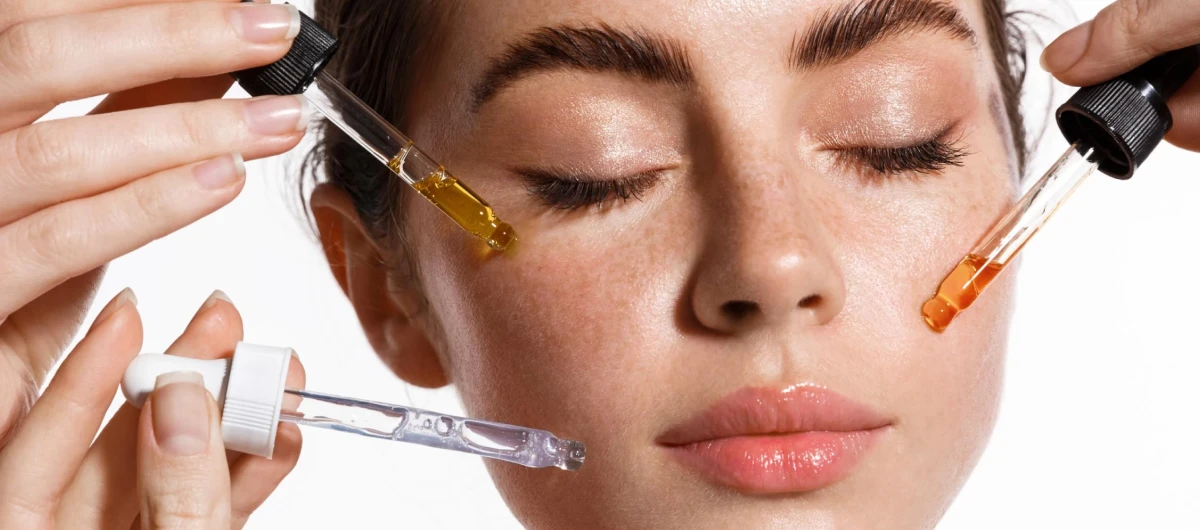What types of acids are there, and how do they differ? Effects, risks, contraindications, and recommendations for use.

Acids in Beauty Routine: Effects and Risks
You’ve probably heard about acids as a magical tool that can significantly improve your skin’s condition and address numerous beauty concerns: lightening pigmentation, smoothing wrinkles, preventing acne, cleaning pores, and more.
Indeed, after reading rave reviews and recommendations about acid-based products on social media, you might be tempted to try them all. But hold on—this might not be the best idea. While acids can significantly enhance your skin, choosing the wrong ones can cause serious damage.
So, let’s get acquainted with these beauty helpers and understand their real powers, as well as the limitations you should be aware of.
How do acids work, and why are they necessary?
Acids help exfoliate the dead layer of skin by breaking down the bonds between cells. In other words, they dissolve the “glue” that binds dead cells to the layers of the skin. This process is known as chemical exfoliation.
Why exfoliate the skin?
Regular exfoliation of the dead skin layer helps maintain a healthy appearance. Dull, lackluster skin, clogged pores, and exacerbated inflammatory processes are often the result of a thick layer of dead cells accumulating on the epidermis’s surface. While the skin can renew itself, this process slows down significantly with age or can be disrupted by factors like illness or environmental impact. This is where exfoliation comes in, with acids being your reliable assistants.
What other effects can you expect from using acids?
Depending on the acid you choose, its concentration in the product, and how correctly you use it, you may experience the following benefits:
- Lightening of pigmentation and post-acne marks
- Smoothing fine lines
- Evening out skin tone
- Reducing sebum production
- Smoothing skin texture
- Clearing up breakouts
- Enhancing the penetration of active ingredients into the skin layers
Types of Cosmetic Acids
In the world of cosmetology, three types of acids are commonly used: Alpha Hydroxy Acids (AHA), Beta Hydroxy Acids (BHA), and Polyhydroxy Acids (PHA).
AHA Acids
AHA acids are the largest group of acids. Popular examples include glycolic, lactic, mandelic, malic, and tartaric acids.
Effects:
These work exclusively on the skin’s surface and are used to exfoliate dead cells. AHA acids can even out skin tone, smooth texture, eliminate dullness, and lighten pigmentation.
Risks:
Improper use of AHA acids can cause irritation, especially if you have sensitive skin. Additionally, they increase sun sensitivity, so if you’re using them, never skip SPF.
BHA Acids
BHA acids are the easiest to remember, as only one is used in cosmetology—salicylic acid.
Effects:
Unlike AHA acids, salicylic acid can penetrate deep into the pores. This means it not only exfoliates dead cells but also clears out accumulated sebum from the pores. Moreover, salicylic acid has antibacterial and anti-inflammatory properties, which is why it remains a top ingredient for oily, acne-prone skin.
Risks:
Overuse of BHA acids can dry out the skin. High concentrations of salicylic acid can also cause irritation.
PHA Acids
PHA acids are a newer generation of exfoliating agents compared to AHA and BHA. Examples include gluconolactone and lactobionic acid.
They have larger molecules, making them gentler than other acids and less likely to cause irritation. They work on the skin’s surface, exfoliating very gently, and they can also attract and retain moisture in the skin.
Risks:
Since the action of PHA acids is gentler compared to others, the risks are minimal (except for the possibility of an individual reaction). However, a downside is the less pronounced effect compared to AHA and BHA acids.
Contraindications for Using Acids in Skincare
Despite all the magical properties of acids, there are times when it’s best to avoid using them.
- Sensitive or irritated skin. If you have very sensitive, irritated skin, or a compromised skin barrier, using acids will only make the situation worse. In such cases, focus on recovery and soothing.
- Active inflammatory processes, wounds, cuts, eczema. Using acids in such cases will cause severe irritation and can slow down the healing process.
- Tendency to allergies. Skin prone to allergies can react unpredictably to acids, so before applying them to your face, test on a small patch of skin (like the inside of your elbow).
- Sunburns. If you have a fresh sunburn, using acids will only increase irritation and significantly slow the healing process.
- Recent cosmetic procedures. If you’ve recently undergone aggressive cosmetic procedures like laser resurfacing, chemical peels, or waxing, using acids can damage the skin and cause severe irritation.
General Rules for Using Acids in Your Beauty Routine
To ensure your experience with acids is comfortable and beneficial, remember (or save) these recommendations.
- Start with a low concentration. If you’re new to acids, begin with a lower concentration to avoid irritation and see how your skin responds.
- Remember graduality. Introduce acids into your routine gradually, starting with once a week and slowly increasing the frequency if your skin reacts well.
- Use acids only in the evening routine. Acids make your skin more sensitive to the sun, so it’s better to use them in the evening. Exception: acid-based cleansers.
- Combining products. Remember: the concentration of acids in products adds up. Using several acidic products simultaneously can cause irritation. Also, be cautious with combinations of acids and other active ingredients.
- Remember to moisturize. After using acids, always apply a moisturizer to help restore the skin barrier and retain moisture.
- Sun protection is a must. Since acids increase your skin’s photosensitivity, not using SPF in your daily routine can lead to undesirable consequences.
- Listen to your skin. If you notice irritation, unusual redness, or peeling, reduce the frequency of acid use or take a break.
- Conduct an allergy test. Before using a new acid product for the first time, apply it to a small area of skin and wait 24 hours to ensure there’s no allergic reaction.
- Consult a specialist. If you have skin conditions or are unsure about choosing and using acids, you can always seek advice from a dermatologist or a cosmetology specialist.
- Store acid-based products properly. Follow the storage instructions on the label. They’re usually best kept in a cool place, away from direct sunlight (but not in the refrigerator).



I’m really impressed together with your writing abilities as well as with the layout on your weblog. Is that this a paid subject or did you customize it yourself? Either way keep up the nice quality writing, it’s rare to peer a great weblog like this one these days!